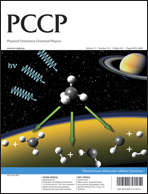Vector correlations in photodissociation of polarized polyatomic molecules beyond the axial recoil limit
Abstract
We present the full quantum mechanical theory of the angular momentum distributions of photofragments produced in photolysis of oriented/aligned parent polyatomic molecules beyond the axial recoil limit. This paper generalizes the results of Underwood and Powis28,29 to the case of non-axial recoil photodissociation of an arbitrary polyatomic molecule. The spherical tensor approach is used throughout this paper. We show that the recoil angular distribution of the angular momentum polarization of each of the photofragments can be presented in a universal spherical tensor form valid for photolysis in diatomic or polyatomic molecules, irrespective of the reaction mechanism. The angular distribution can be written as an expansion over the Wigner D-functions in terms of the set of the anisotropy-transforming coefficients which contain all of the information about the photodissociation dynamics and can be either determined from experiment, or computed from quantum mechanical theory. An important new conservation rule is revealed through the analysis, namely that the component qi of the initial reagent polarization rank Ki and the photofragment polarization rank K onto the photofragment recoil direction k is preserved in any photolysis reaction. Both laboratory and body frame expressions for the recoil angle dependence of the photofragment angular momentum polarization are presented. The parent molecule polarization is shown to lead to new terms in the obtained photofragment angular distributions compared with the isotropic case. In particular, the terms with |qi| > 2 can appear which are shown to manifest angular momentum helicity non-conservation in the reaction. The expressions for the coefficients
which contain all of the information about the photodissociation dynamics and can be either determined from experiment, or computed from quantum mechanical theory. An important new conservation rule is revealed through the analysis, namely that the component qi of the initial reagent polarization rank Ki and the photofragment polarization rank K onto the photofragment recoil direction k is preserved in any photolysis reaction. Both laboratory and body frame expressions for the recoil angle dependence of the photofragment angular momentum polarization are presented. The parent molecule polarization is shown to lead to new terms in the obtained photofragment angular distributions compared with the isotropic case. In particular, the terms with |qi| > 2 can appear which are shown to manifest angular momentum helicity non-conservation in the reaction. The expressions for the coefficients  have been simplified using the quasiclassical approximation in the high-J limit which allows for introducing the dynamical functions and the rotation factors which describe the decreasing of the photofragment angular momentum orientation and alignment due to the rotation of the molecular axis during photodissociation. In this case, the resultant recoil angle dependence is also presented in a form where the anisotropy of the parent molecular ensemble is expressed in terms of the molecular axis distribution, rather than in terms of the molecular density
have been simplified using the quasiclassical approximation in the high-J limit which allows for introducing the dynamical functions and the rotation factors which describe the decreasing of the photofragment angular momentum orientation and alignment due to the rotation of the molecular axis during photodissociation. In this case, the resultant recoil angle dependence is also presented in a form where the anisotropy of the parent molecular ensemble is expressed in terms of the molecular axis distribution, rather than in terms of the molecular density

- This article is part of the themed collection: Molecular Collision Dynamics

 Please wait while we load your content...
Please wait while we load your content...